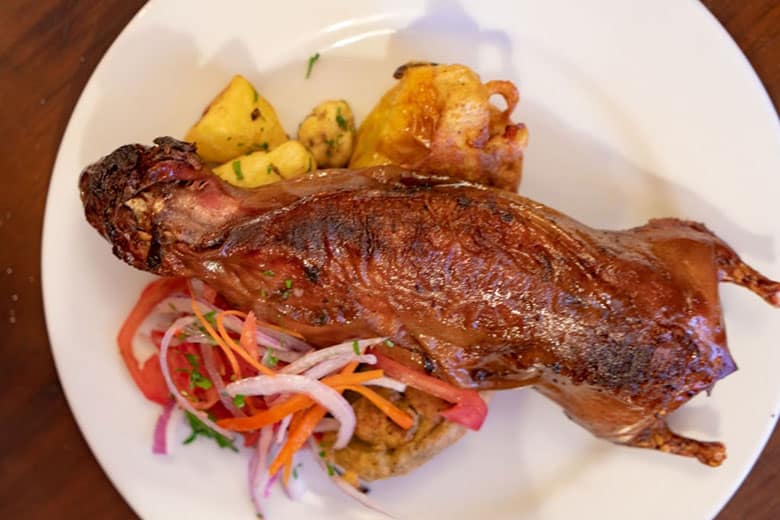Food & Diet
What Does Guinea Pig Taste Like?
Guinea pigs, also known as “cuy” in Peru, are a popular food source in some regions of South America. While they may be considered cute and cuddly pets in many parts of the world, in countries like Peru, Ecuador, and Colombia, they are commonly served as a delicacy. But for those who have never tasted guinea pig before, the thought of eating one can be quite daunting. So, what does guinea pig taste like? Let’s find out.
Seemore: Can Guinea Pigs Eat Zucchini? – Health Benefits And Drawbacks
Contents
The History of Eating Guinea Pigs

Before we dive into the taste of guinea pig, it’s important to understand the history behind eating them. In South American countries, guinea pigs were domesticated thousands of years ago by the Incas. They were not only kept as pets but also used as a source of food. In fact, there is evidence that suggests guinea pigs were bred specifically for their meat and were considered a high-protein food source for the Incan people.
Today, guinea pig is still a staple food in many Andean communities, especially in rural areas. It is often served on special occasions, such as weddings or festivals, and is seen as a symbol of prosperity and celebration.
The Taste of Guinea Pig

Flavor Profile
The taste of guinea pig can be described as a cross between poultry and rabbit meat. It has a mild, slightly gamey flavor with a hint of sweetness. This is due to the animal’s diet, which mainly consists of grasses, herbs, and vegetables. Some people even claim that guinea pig tastes similar to chicken.
Texture
In terms of texture, guinea pig meat is lean and tender, with a slight chewiness. It is comparable to rabbit meat in this aspect. However, the texture can vary depending on how it is prepared. When roasted, the skin becomes crispy, while the meat inside remains juicy and soft.
Preparation
In South America, guinea pig is usually prepared by roasting or frying whole. It is often served on a skewer or with its head and feet still intact. Some also like to eat it in a soup or stew. The traditional way of cooking guinea pig involves marinating it in spices and herbs and then slow-roasting it over an open fire.
Nutritional Value of Guinea Pig Meat

Guinea pig meat is considered a good source of protein, with around 21 grams per 100-gram serving. It also contains essential vitamins and minerals, such as iron, zinc, and vitamin B-12. However, it is relatively high in fat, with around 8 grams per serving, so it should be consumed in moderation.
Comparison to Other Meats
Compared to other meats commonly consumed in Western diets, such as beef, chicken, and pork, guinea pig meat has a similar nutritional profile. However, it does have slightly higher levels of iron and less cholesterol than beef. It is also lower in calories compared to chicken.
Cultural Significance
In addition to being a food source, guinea pigs hold cultural and spiritual significance for Andean communities. In some cultures, they are believed to bring good luck and prosperity to a household. Their bones are used in traditional healing practices and rituals, and their fur is used for making textiles and clothing.
How to Prepare Guinea Pig for Consumption

Preparing guinea pig for consumption can be quite different from what we’re used to in Western diets. Here are two common methods of preparing this delicacy:
Roasting
Roasting is the most popular way of preparing guinea pig in South America. The animal is typically marinated in spices and herbs, such as cumin, oregano, and garlic. It is then placed on a spit and roasted over an open fire until it is golden brown and crispy on the outside. The skin is usually eaten, as it adds a nice crunch to the dish.
Frying
Frying is another common method of preparing guinea pig. The animal is cut into smaller pieces and deep-fried until it is crispy and golden brown. It is often served with potatoes and vegetables on the side.
FAQs about Eating Guinea Pig

1. Is it ethical to eat guinea pigs?
In some cultures, eating guinea pigs is a way of life and is seen as no different from consuming other types of meat. However, in Western cultures where guinea pigs are commonly kept as pets, it may be considered unethical.
2. Is it safe to eat guinea pig meat?
Yes, guinea pig meat is safe to eat. However, it is important to make sure it is properly cooked to avoid any potential foodborne illnesses.
3. Can everyone eat guinea pigs?
Guinea pig meat is not suitable for people with certain dietary restrictions or allergies. It is also not recommended for pregnant women or young children.
4. Are there any health benefits to eating guinea pig meat?
Like most meats, guinea pig meat is a good source of protein and essential nutrients. However, it should be consumed in moderation as part of a balanced diet.
5. How can I try guinea pig if I don’t live in South America?
Some restaurants in Western countries, particularly in cities with large South American populations, may offer guinea pig on their menu. You can also find recipes online and prepare it at home.
Conclusion

In conclusion, guinea pig may not be a food that everyone is willing to try, but for those who do, the taste can be quite enjoyable. With its mild flavor and tender texture, it is a delicacy that has been enjoyed for thousands of years in South America. While it may seem unconventional to some, guinea pig is an important part of the culture and cuisine in many Andean communities. So, if you ever have the opportunity to try it, don’t be afraid to take a bite and discover for yourself what this unique meat tastes like.
